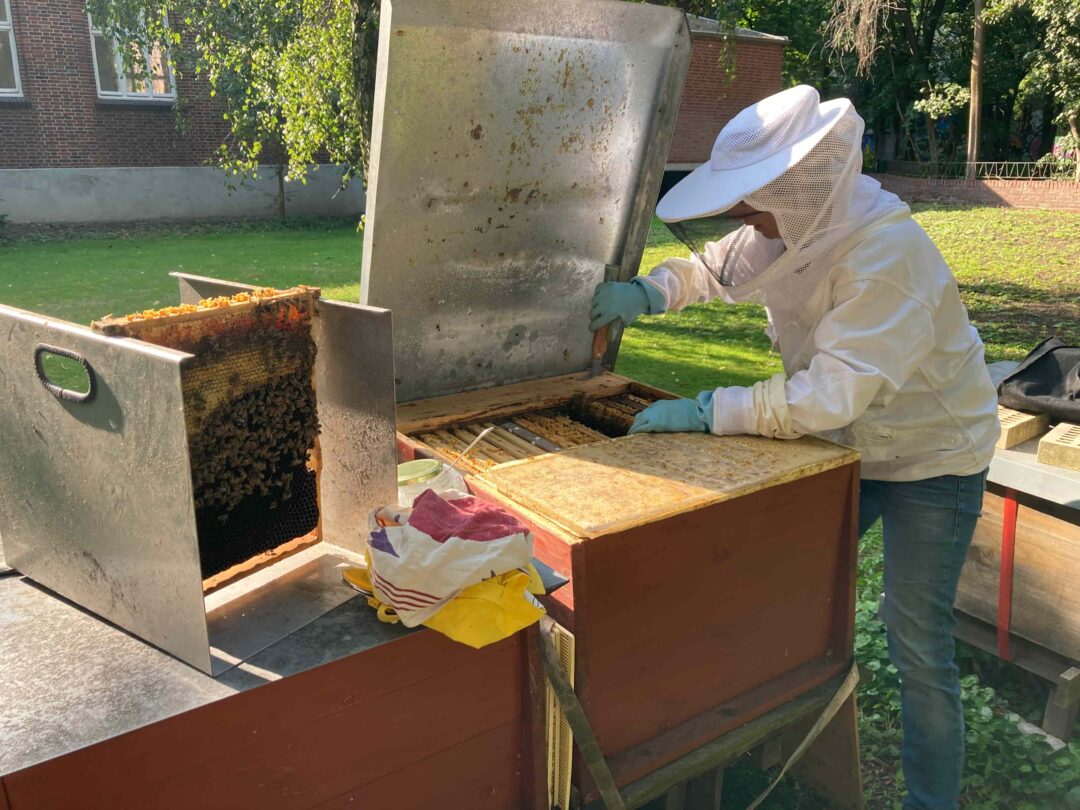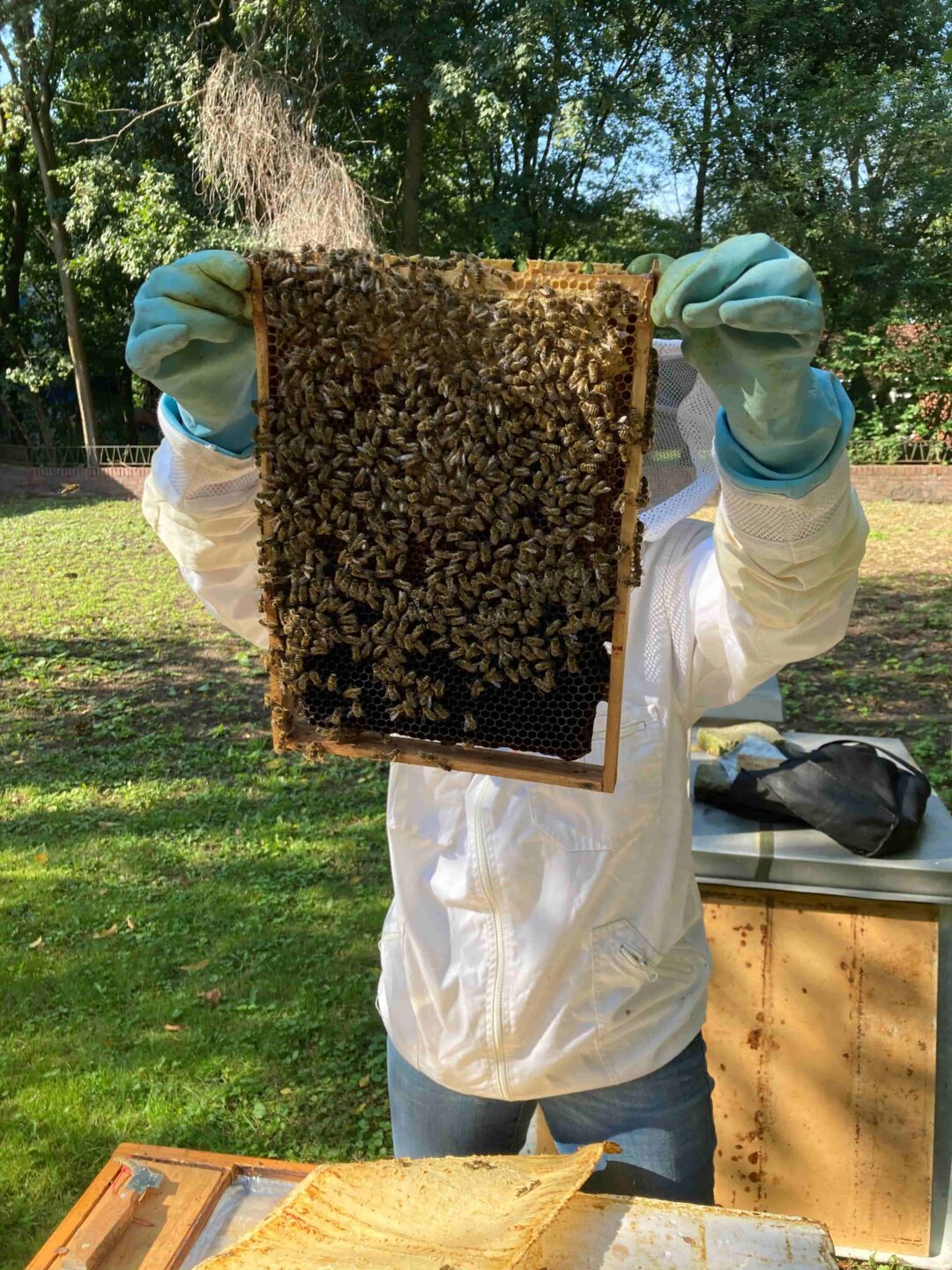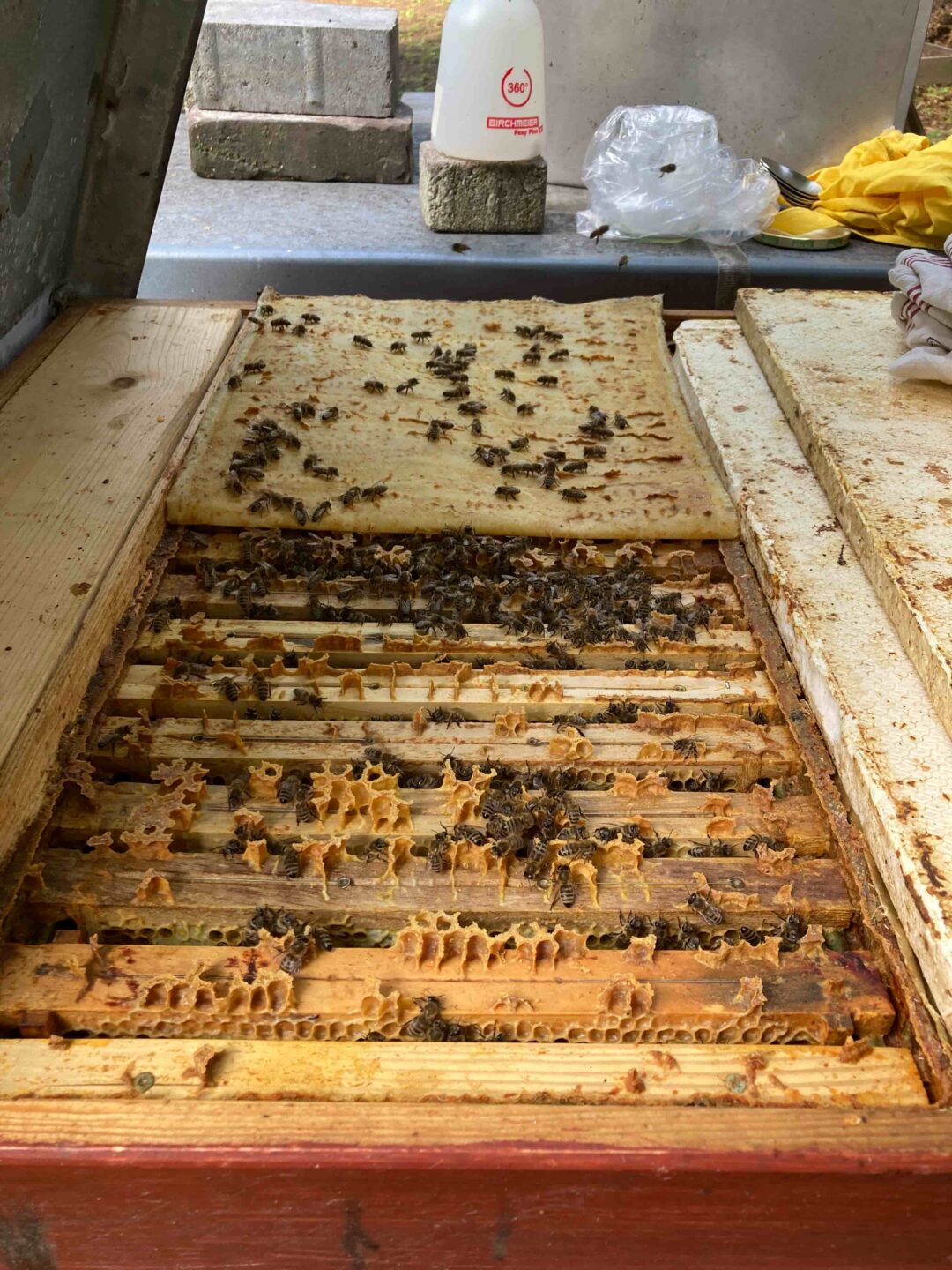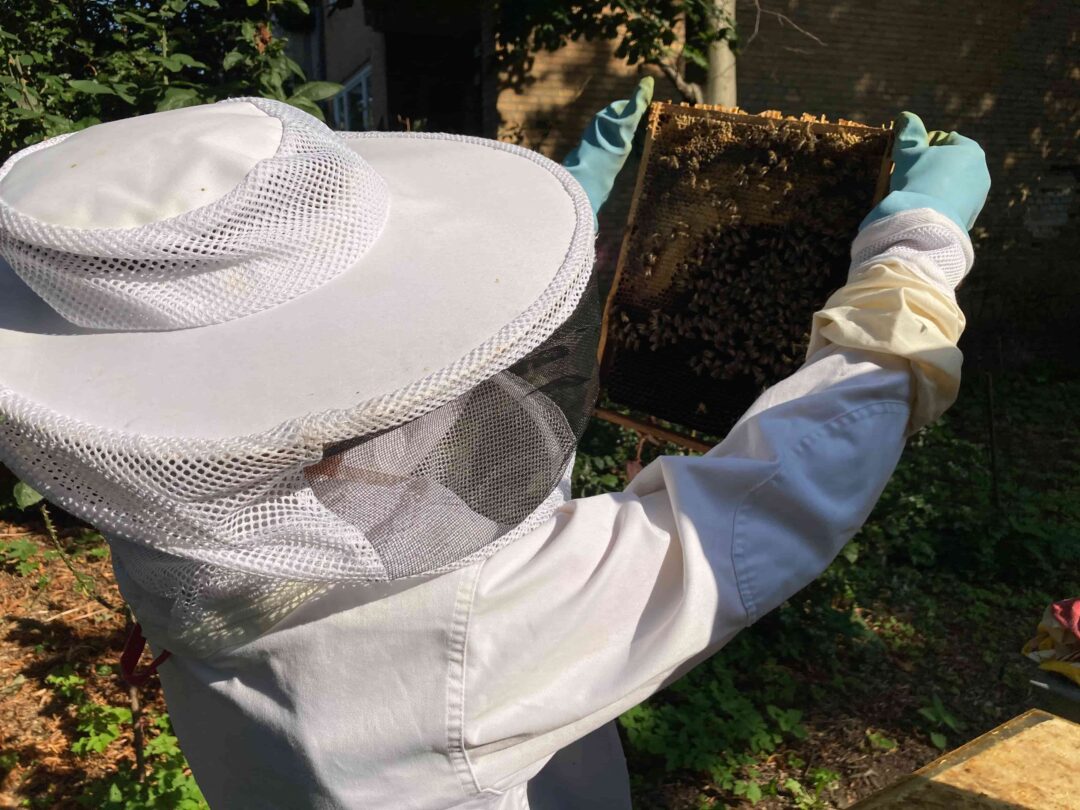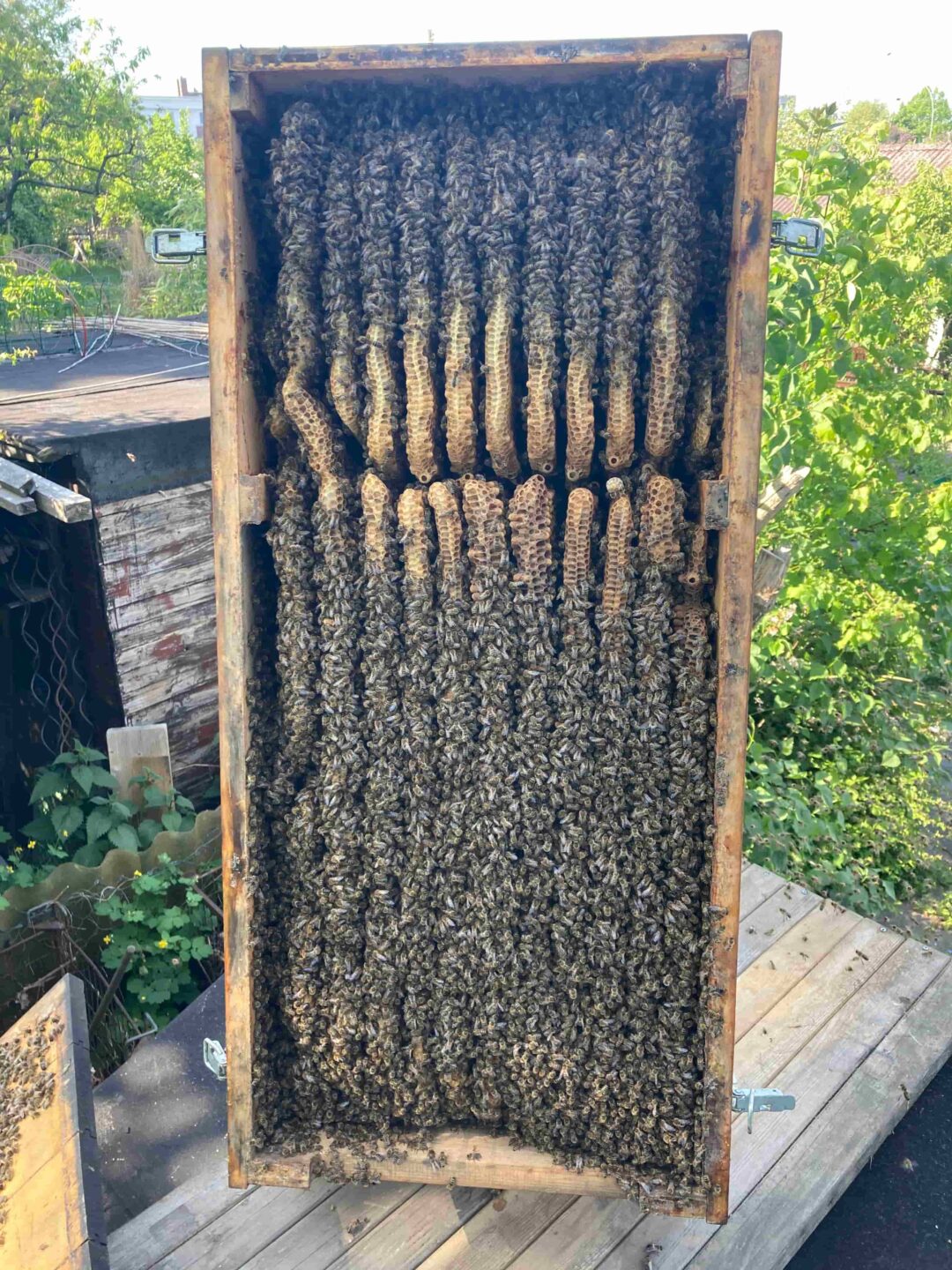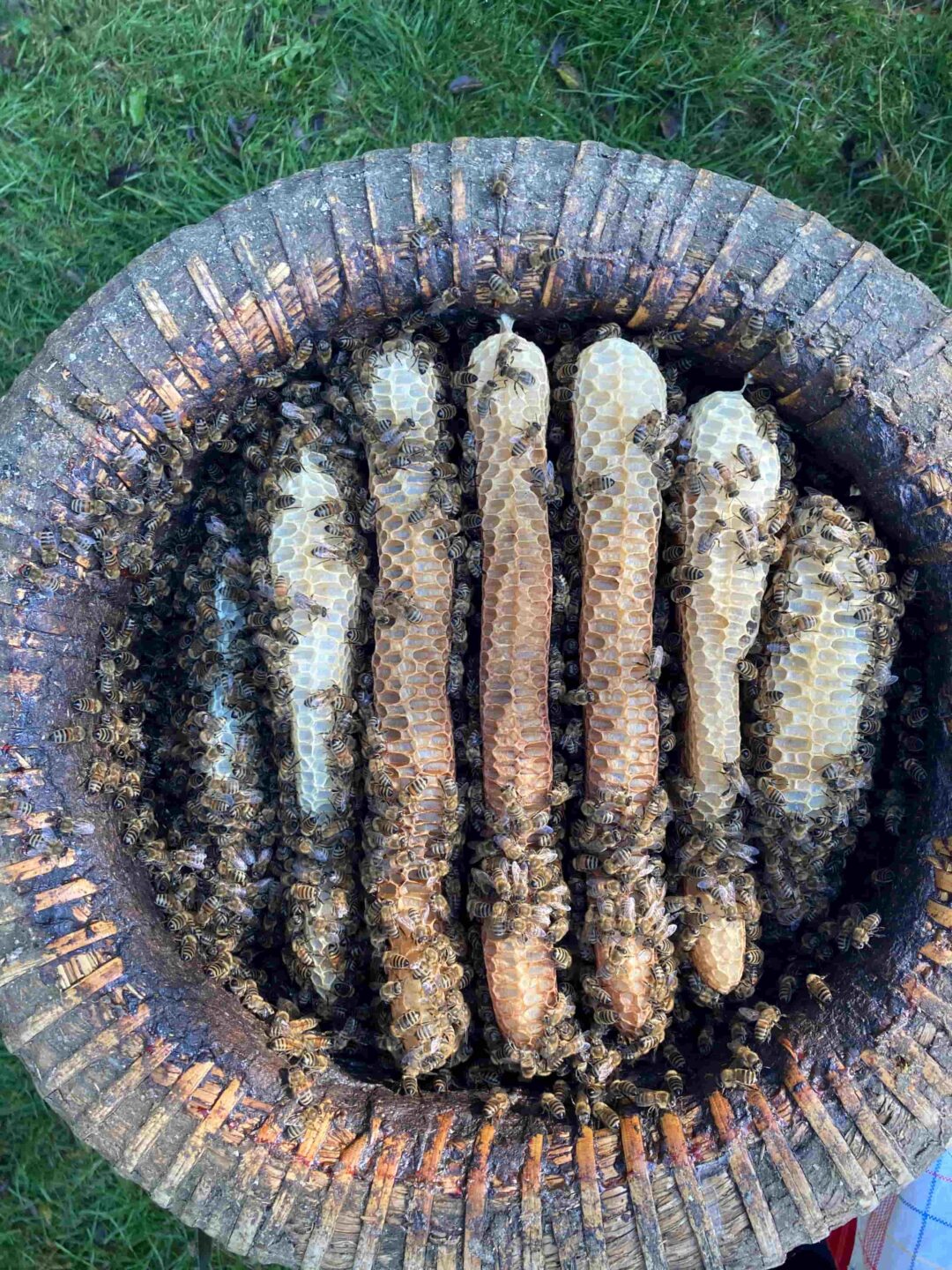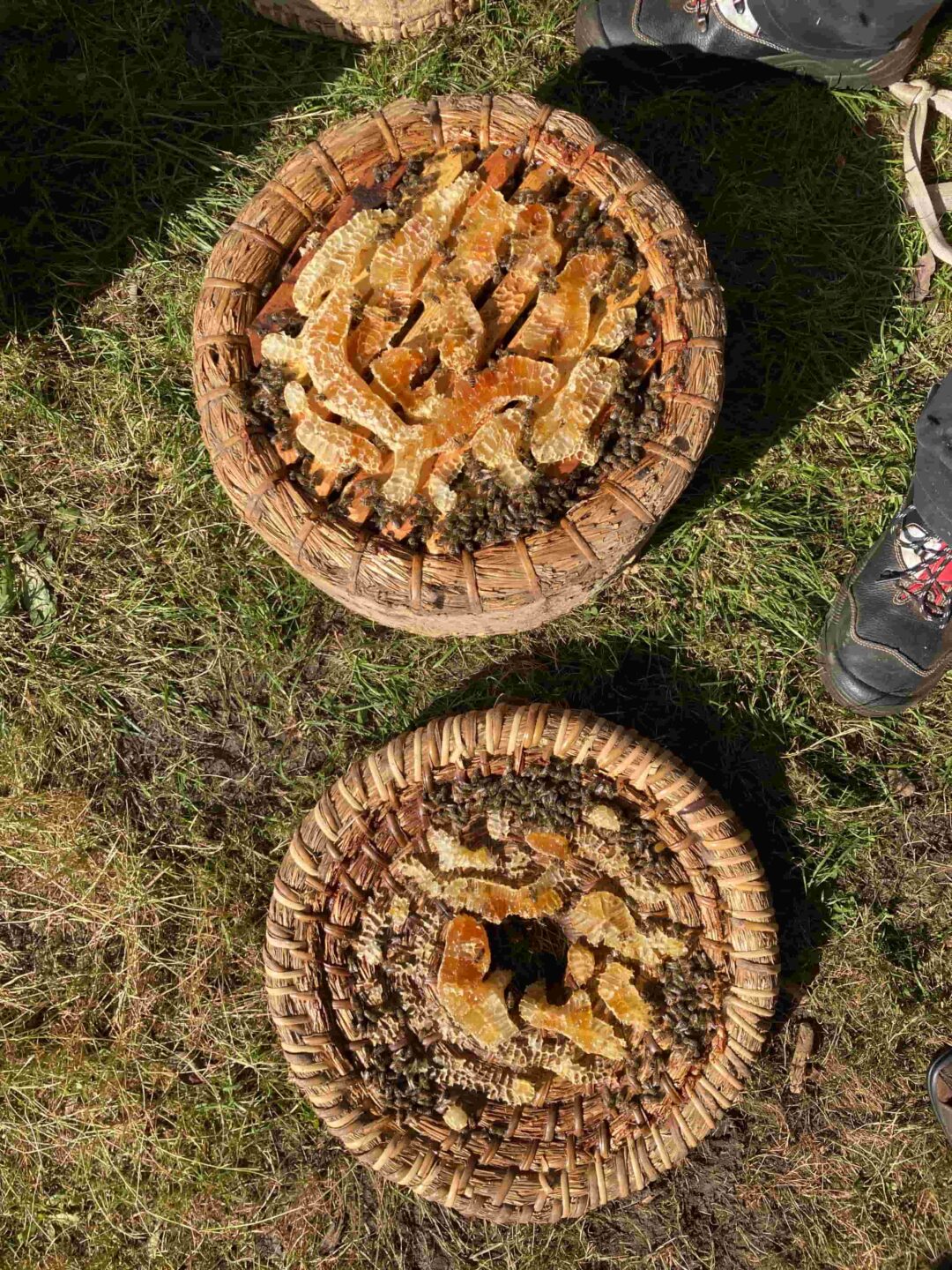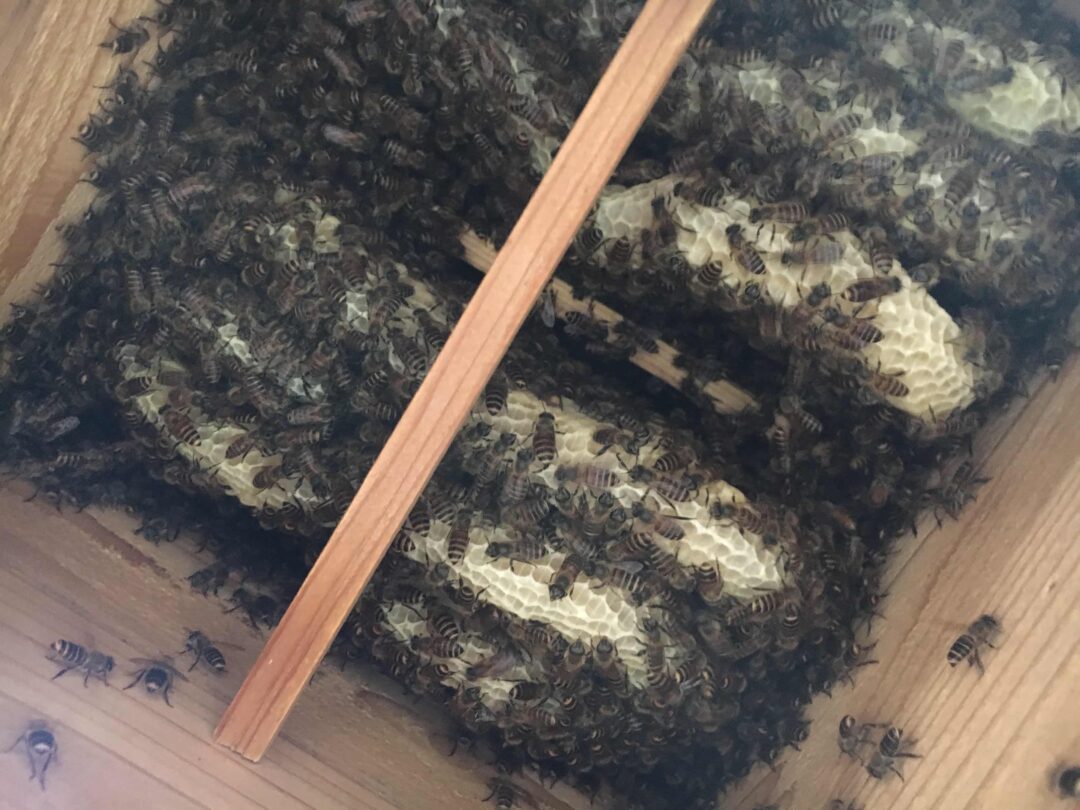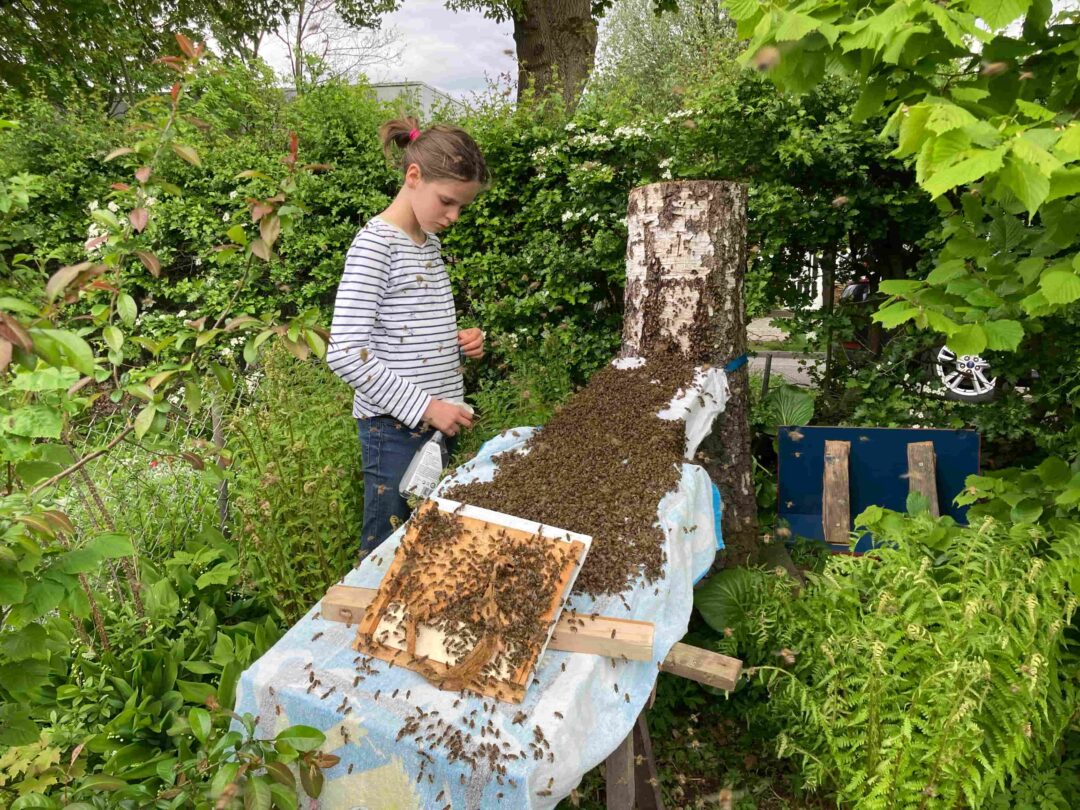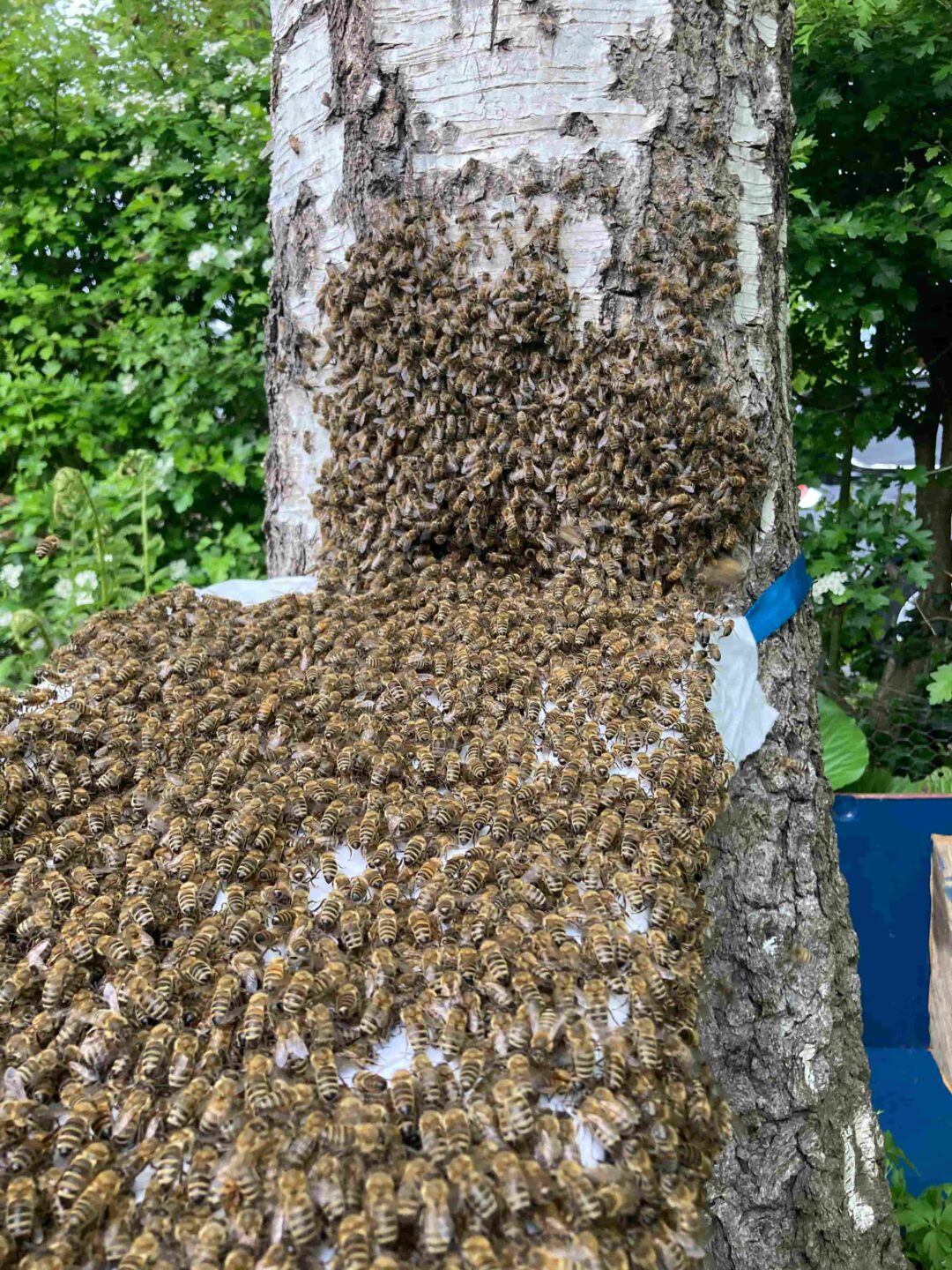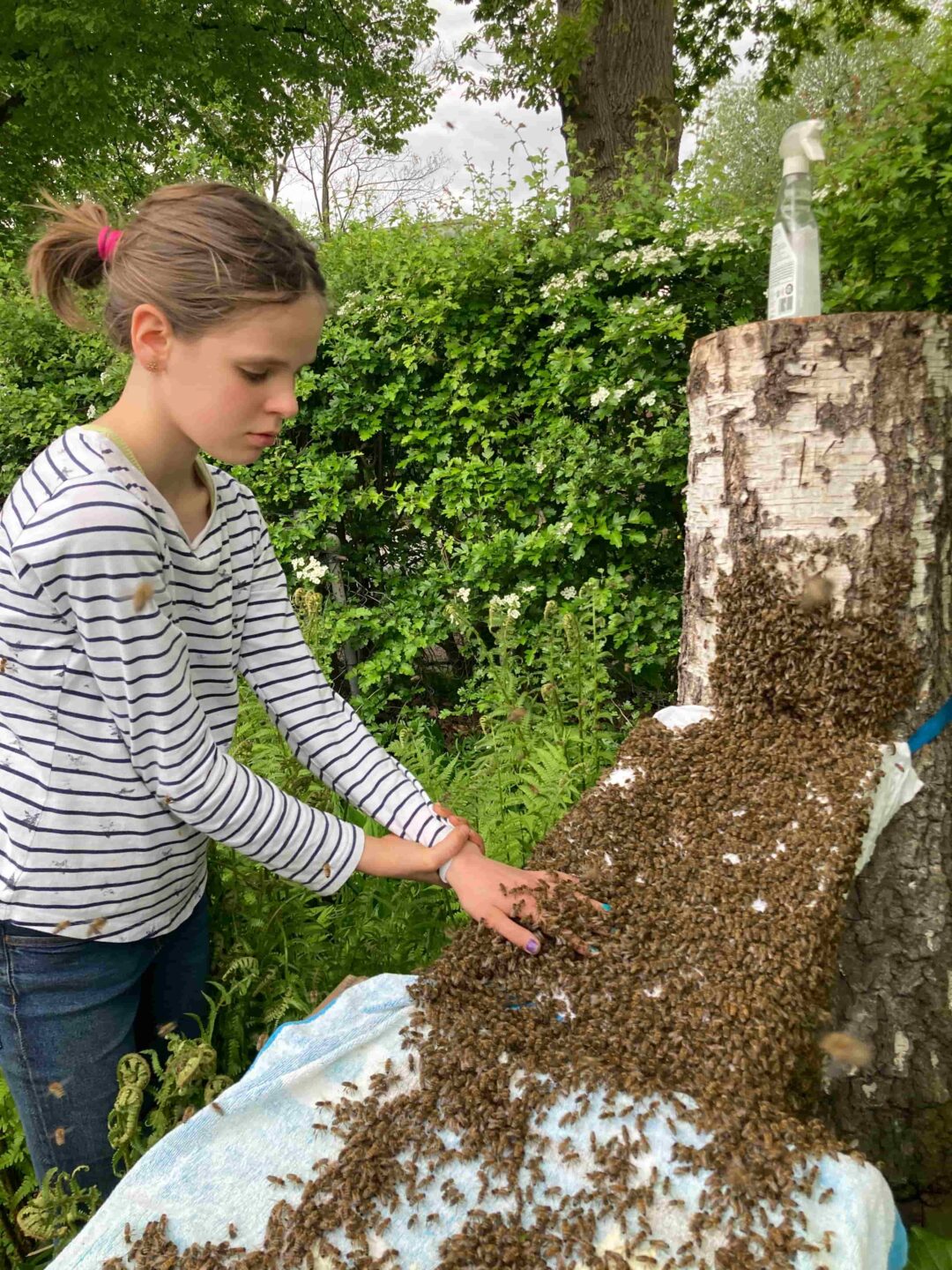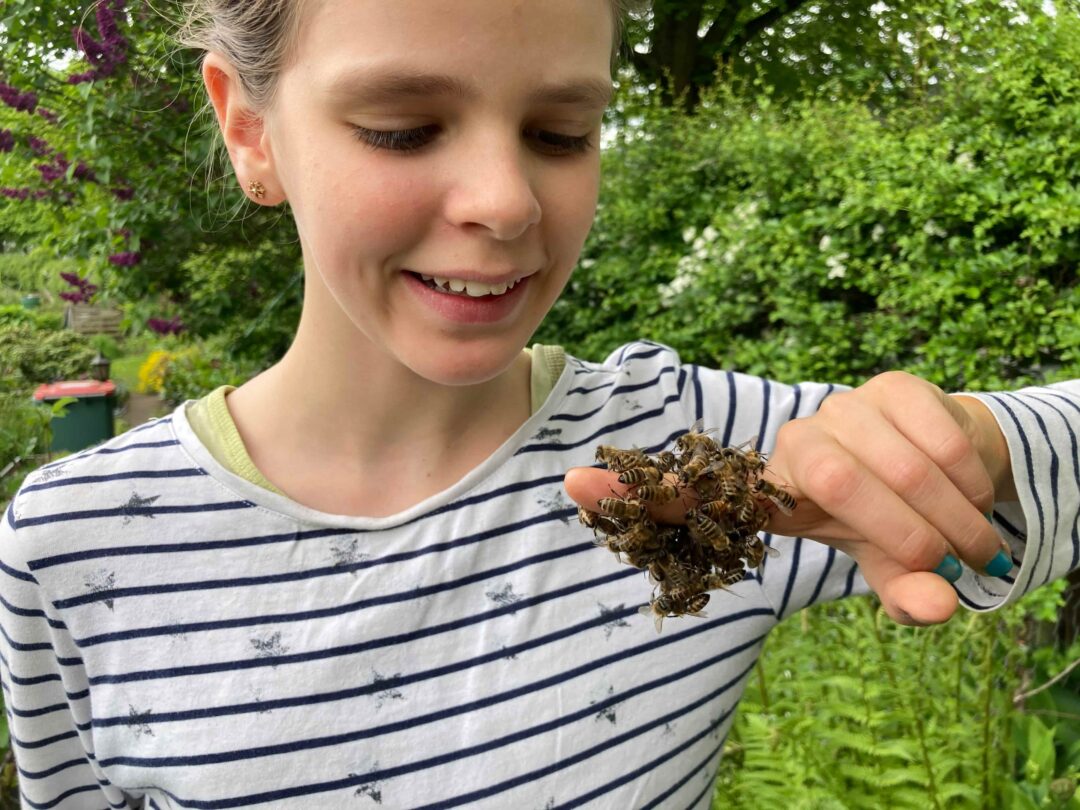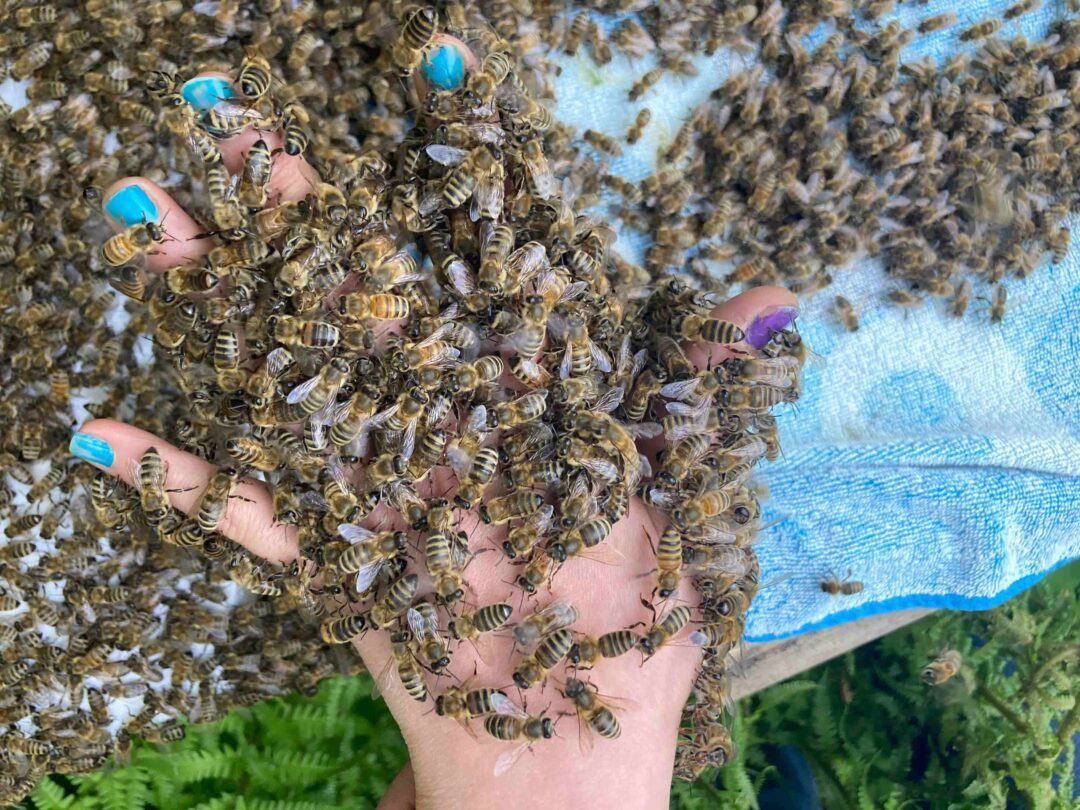Sensing Bees
Martin Gruber
BeeCultures: Ethnographic Research on Human-Honeybee Entanglements
As a visual anthropologist and filmmaker at the University of Bremen I have been conducting ethnographic research on human-honeybee entanglements since 2013. The intimate relationship between humans and honeybees – often mediated by other living and non-living agents – is at the heart of my research project BeeCultures. In my aim to highlight and evoke the importance of sensorial aspects in this relationship, this website constitutes an experiment in multimodal ethnography that brings together ethnographic writing with audio-visual research output.
This website is optimized for laptop and desktop computers. Please press esc to exit images in full screen view.
Since the Pleistocene humans have been collecting and consuming the produce of bees. Mostly honey but also wax, pollen and propolis. People all over the world have developed various methods of foraging the products of untended bee colonies and of keeping bees in human-made hives. Beekeepers developed their practices mostly on the basis of the locally available building materials for hives. The different species and sub-species of bees that populate different environments have various traits and behaviors that equally shape these relationships. A central concern of my research is to work out how humans and animals mutually influence each other. One can speak of veritable human-honeybee cultures.
Multispecies Ethnography
My research on human honeybee entanglements is based on the view that we live in a ‚multispecies world‘ in which humans, animals, plants, microbes as well as inanimate matter are interwoven in multiple ways (Tsing 2010; see also Kirksey and Helmreich 2010). Multispecies research, in contrast to human-animal research, is not concerned with examining the relationship between humans and a particular animal, but
a multispecies approach focuses on the multitudes of lively agents that bring one another into being through entangled relations that include, but always also exceed, dynamics of predator and prey, parasite and host, researcher and researched, symbiotic partner, or indifferent neighbor … this immersive approach is now also increasingly being applied to forms of liveliness that many, but by no means all, of us would consider to be nonliving: from stones and weather systems to artificial intelligences and chemical species. (van Dooren, Kirksey, and Münster 2016, 3–4)
Crucial for the multispecies turn was a departure from a clear separation between nature and culture, which can be traced back to Donna Haraway’s concept of naturcultures (2003). The realization that culture and nature cannot be thought of as separate entities is closely connected to the increasing environmental destruction and related phenomena such as climate change, the loss of biodiversity and the devastation of entire landscapes through extraction, urbanization, and other human-made phenomena. These developments have contributed to the emergence of the concept of the Anthropocene, that geological epoch in which man-made effects on the earth override the effects of other factors.
Following a multispecies approach, my research focuses on assemblages of humans, honeybees, other animals, plants and non-living matter (Tsing 2015). I treat honeybees and other species as well as objects and material as active agents in my research on human-honeybee entanglements as they interact with each other and have an impact on the world. At the same time, it is difficult to communicate with bees and a establish mutual communication. My understanding is that bees do have feelings and do suffer (Haraway 2008). To interpret the bees’ behavior and their interaction with humans as intentional seems too speculative and tends to be anthropomorphizing. I see their agency in the way they impact in the world rather than intentional.
I have been looking at the relationships between humans and honeybees in three different fields constituted by three different sub/species of honeybees and their human counterparts: 1. Hamburg, Germany and a hybrid mix of Apis mellifera sub-species, 2. Ngaoundéré, Cameroon and Apis mellifera adansonii, and 3. Kyoto, Japan and Apis cerana japonica.
Humans, Honeybees and the Senses
Sensorial aspects are at the core of the human-honeybee encounter – and of my multispecies research. Beekeeping and other interactions between humans and bees are grounded in sensory perceptions. Moreover, the fascination of bees is often triggered by sensory experiences and feelings. Physical proximity to bees thereby plays an important role. This is however difficult and ambivalent due to the bees’ defensive behavior and their ability to sting. Interacting with bees is often a compromise between proximity and distance or protection. Objects and materials mediate the relationship between humans and bees – in the form of beehives, protective gear, tools and medication. With this website, I want to focus on three interconnected aspects: 1. Sensory Perception and Beekeeping, 2. Materiality and Aesthetics, and 3. Proximity and Distance.
Sensory Perception and Beekeeping
Humans perceive themselves and their environment first and foremost with their senses (MacDougall 2006). The contact between humans and honeybees is also based on sensory perception. The visual sense is central, but the other senses also play an important role. The first impressions that humans get of honeybees may be observations of bees on flowers or at the entrance of a hive. These make it possible to assess individual bees. Inspecting or ‚looking through‘ colonies is one of the most important activities in beekeeping. After opening the hive, the combs in their frames are pulled out one after the other and systematically inspected on both sides. Observations of bees and their behavior as a group allow important conclusions about the condition of the colony. Assessing the type and quality of honeycomb, the amount of stored honey as pollen as well as the brood provide additional information. These inspections in the sense of ‚looking through‘ a colony are only possible with movable frame hives. Fixed comb hives with immovable honeycombs allow only a partial visual inspection which enables less (visual) information on the colony. This shows how materiality impacts beekeeping practice.
Besides visual impressions and observations, hearing, smelling and touching are important for beekeeping practice. Through sensory perceptions problems such as diseases, parasites, queenlessness or lack of food can be detected early and countermeasures can be initiated. Queenless or aggressive bees, for example, produce different sounds than calm and peaceful bees. The touching of comb and bees are an additional indicator. Multisensory attentiveness guides the interactions between humans and bees and allows humans to draw conclusions about the state of the colony. Sensing the bees needs to be learned in a process of ‚enskillment‘ (Grasseni 2018). Enskillment is not about interpreting ‚objective‘ information ‚correctly‘. Rather, it is a process of negotiation through which sensory perception is learned in a culturally and socially specific context.
Beekeeping practice and its learning is based first and foremost on recognizing visual features of bees, comb and brood. Beginners need to be able to recognize and interpret certain phenomena in order to plan beekeeping measures and put them into practice. Typically, they first learn to distinguish worker bees from drones. Then they learn to recognize whether honey is stored in the covered cells of the comb, or the larvae of female or male bees. Worker brood has darker cell covers while honeycombs have a whitish-yellow waxy cover. Newbies learn to recognize and interpret sensory information primarily through experienced beekeepers – either in direct contact, for example in exchange with beekeeper mentors, or in beekeeping courses – or mediated through video tutorials, books, journals or instructions on the internet.

Materiality and Aesthetics
Objects, materiality and aesthetics play central roles in the relationship between humans and bees. For millennia, humans have been creating movable and immovable cavities in which to lodge colonies of honeybees in order to harvest their honey. The materials they use and the different types of constructions they create have a fundamental effect on the type of beekeeping and thus on the relationship between humans and bees. A fundamental difference is the one between immovable comb hives and mobile frame hives as they offer differing possibilities of control and intervention.
Immovable comb hives have been common for millennia. The bees attach their comb directly to the inner surface of the hive. In such hives only a very small portion of the comb and bees are visible – mostly by opening an inspection hatch or by turning the hive upside down. This makes it difficult to inspect the hive thoroughly and manipulate the bee colony in a controlled way. When harvesting the honey of such hives, the honey (filled) combs have to be cut out– usually with special tools. The honey is separated from the comb with a sieve or filter cloth. Immovable comb hives yield a special type of honey with a particular taste.
Hives with mobile frames were introduced in the 19th century in an effort to enable more analytical and efficient beekeeping with maximized honey yields, to avoid swarms and diseases, and directed pollination through migration. The bees construct their comb in wooden frames that can each be removed from the hive. This makes it possible to view the entire comb of a colony and assess the brood and amount of stored honey. When harvesting honey, the frames with honey-comb are removed and the honey is extracted with the use of a honey extractor or centrifuge. The comb structure stays intact and can be re-inserted into the hive. The bees do not have to construct new comb.
The hives made by beekeepers around the world are made of a wide variety of materials (Crane 1999). Traditionally, these were locally available materials that were simple and cheap, such as tree trunks or bark, rods, straw, grass and other plant fibers, as well as loam or clay. Depending on which materials were available, locally specific methods of beekeeping developed. Examples are beekeeping with log hives and skeps in central and northern Europe. Cylindrical hives made of loam or clay are predominant throughout the Mediterranean and North Africa. Log hives and hives made of plant fibers are also common in southern Europe. In sub-Saharan Africa, cylindrical beehives made of plant fibers or bark as well as log hives are common, depending on availability.
Building hives from self-collected natural resources requires in-depth knowledge of the materials used and of the local biosphere more broadly. Among other things, the following questions are important: Where can certain plants or soils be found? What is the best time of year to harvest them? How can certain materials be further processed? In addition, beekeepers need strong manual skills to manufacture the hives out of these materials. This applies in a similar way to beekeepers who build their hives out of boards. Which wood has particularly good properties? Where can I buy the material? What is the best way to process a material? With which means do I treat the surface of my hive?
Historical and contemporary beehives from all over the world can be seen as masterpieces of craft and art. The necessary physical engagement with the environment and the respective materials are documented in my films on beekeeping in Angola and Cameroon (Antónia et al. 2013; Gruber 2015). In the alternative beekeeping scene in Germany it is also very common to manufacture one’s own hives. Building instructions and tutorials can be found in books and online. Kits with particularly high-quality materials are available for sale. The revitalization of old techniques has increased significantly in recent years. Courses on skep beekeeping and forest beekeeping are offered throughout Germany and internationally. Participants learn how to make these types of beehives themselves. This movement is not only about learning historical techniques and approaches. Many beekeepers believe that tree trunks are a natural way of controlling the Varroa mite and generally make the bees healthier and more resistant. For many beekeepers, effort and cost play a subordinate role.
Contemporary beekeepers attach great importance to visually appealing hives. Aesthetic aspects go beyond functionality. Decorating or painting self-made or purchased hives is very popular. This phenomenon can be traced back to a long tradition of “Bannkörbe” and “Figurenbeuten”in the German speaking world. Another approach is to produce hives sustainably – out of cheap or recycled material – with a corresponding aesthetic. Examples are in driftwood or cheap plywood from hardware stores. When making and designing hives, beekeepers build up intense physical and emotional relationships with the material. The resulting objects are imbued with meaning and feelings.
Proximity and Distance
Humans have long been fascinated, enchanted even, by bees. Enchantment goes beyond intellectual curiosity. It involves intense feelings of awe, wonder and love (Barlow 2017). On the one hand, this fascination stems from the perception that bees are complex social beings that are intellectually close to humans. For example, individual bees work for the benefit of the entire colony. Queen, drones and worker bees each have different functions. Worker bees accomplish different tasks throughout their lives. Therefore, bee colonies have been described as super organisms, whereby the colony is regarded as the individual and not the single bee. Honeybees use a complex dance language in order to communicate with each other and humans have managed to decipher this language. As a consequence of these aspects, people tend to humanize bees and to use them as symbols or metaphors – very often in an idealized way. Many beekeepers talk to their bees while working on the hive. However, most of this talking is unidirectional. From my perspective, purposeful communication between humans and bees is not possible.
On the other hand, I want to argue that enchantment is triggered by immediate sensory perception: The sight, sound, smell and touch of bees may trigger intense emotional and even physical reactions in humans. Physical proximity to bees is also important for beekeepers. Many beekeepers prefer to work with as little protection as possible or even none at all. They usually argue that protective gear hinders their sensory perception and renders their movements clumsy. In addition to these functional arguments, cultural scientists have interpreted the decision not to use protection as a desire for an intimate and equal relationship with the bees (Green and Ginn 2014). Some beekeepers believe that not being stung is a sign of a good relationship with the bees (Marx 2017). Barlow (2017) interprets beekeeping without a veil as a ritual through which proximity is established.
The wish for physical proximity is made difficult by the bees’ defensive behavior. The bodies of female honeybees are equipped with a stinger and a venom bladder filled with poison, which is located in the abdomen. When a bee colony feels threatened, it defends itself: guard bees fly at the source of the threat and circle around it whether it be human, animal or even an inanimate object. If the threat persists, bees may sting deliberately. Sometimes they may sting the threat immediately. With each sting, pheromones are released that encourage other guard bees to attack. This can lead to massive attacks and large numbers of stings.
When honeybees sting humans or other mammals, the barbed stinger remains stuck in the skin. If the bee flies up after stinging, the stinger gets torn off the bee’s abdomen along with the poison bladder. All the venom in the bladder enters the body of the stung animal or human. The bee dies. In humans, the bee venom causes the affected part of the body to swell within a short time. The swelling usually goes down after a few days. While the sting initially causes severe pain this is overlaid by itching that lasts about as long as the swelling. Stings in the head are particularly painful and stings in parts of the body with thin skin swell up especially badly. The physical reactions to bee stings and the sensation of pain vary greatly from person to person. In some people, bee stings cause allergic reactions that can lead to anaphylactic shock. The intensity of the reactions can change over a person’s lifetime. For most people who are stung regularly, the reactions subside over time. They develop a kind of resistance but this decreases again as soon as they are stung less regularly. There are also beekeepers for whom the reactions become stronger over time, or who develop an allergy to bee venom.
While Apis mellifera are bred throughout Europe to be as docile as possible, some colonies are more defensive than others. Beekeepers describe them as ’stingy‘ or ‚aggressive‘. Bees from around the world differ considerably in this respect. For example, while Apis cerana japonica are particularly docile, African honeybee subspecies are considered extremely aggressive. This is especially true of the so-called ‚africanised‘ bee, a hybrid between European Apis mellifera lingustica and African Apis mellifera scutellata, which was accidentally released in South America and has since spread to the southern USA (Ruttner 2003, 244-53). The differences in the defensive behavior of bee species and subspecies have significant implications for beekeeping practices and human-bee relations.
Precautions against bee stings play an important role in beekeeping practice worldwide. Most honey hunters and beekeepers work with smoke. They spread smoke by burning branches, tufts of grass or dried cow dung, or with special devices such as smokers or beekeepers‘ pipes before and during work on the hive. The administration of smoke triggers the reaction that the bees prepare (as in a forest fire) to leave their hive (to escape the fire). As a precaution, they fill their honey stomachs with a supply of honey, which calms them. Blowing smoke at bees can also help to push them back or direct them.
Most beekeepers wear protective clothing. These consist primarily of a veil-like head covering to protect the wearer’s entire head from stings. Such veils can also be combined with a jacket or overalls (beekeeper’s suit) so that the entire body is protected from stings. Gloves are also used by many beekeepers. In addition to professional protective clothing produced especially for beekeepers, there is also a whole range of locally specific, homemade and improvised utensils.
Swarming
During the reproductive swarming of a bee colony, the old queen leaves the hive with approximately half of her colony’s worker bees. They settle down as a cluster of bees, usually in a nearby tree, then scout bees start searching for a new nesting site. A few days after the prime swarm has left, a number of new queens hatch within the old colony. Since each colony can have only one queen, multiple swarms may leave the hive with one or more princesses. Like a prime swarm, the after-swarms settle down as a cluster until the scout bees find a new nesting site. This process may last up to several days. When the colony agrees on a new site the swarm leaves its open-air cluster and settles down in a new cavity. The finding of a new nesting site has been described as a democratic process (Seeley 2014). The swarming of a bee colony, when tens of thousands of bees leave the hive and cause an incredible buzz, is a highly sensual and emotional experience for most beekeepers.
In Cameroon and Japan, beekeepers attract swarms of bees by baiting hives. In Japan and Germany, it is also common to catch swarms more actively. When a swarm of bees settles down as a cluster, it is possible to shake off the bees into a box and transfer them to a new hive. The swarm season is one of the most important and exhilarating periods of the year – for bees and beekeepers alike. For the bees it’s the reproductive period. Colonies grow extremely fast and multiply. The beekeepers are in a frenzy. Most of them try hard not to let any of their bees ‚escape‘. The colonies need to be inspected regularly to check if they are in a ’swarming mood‘. If this is the case, some beekeepers divide their colonies to prevent swarming. They locate the old queen and transfer her to a new hive along with tens of thousands of worker bees. A so called artificial or anticipated swarm. Others prepare themselves to catch their colonies’ natural swarms. Other beekeepers are busy catching swarms that have ‚escaped‘: under German law, a swarm that cannot be assigned to a particular beekeeper is free to be caught by anyone.
Even though most beekeepers try hard not to let any swarms escape, during the swarm season (from late April to the end of June in Germany and Japan) many swarms occur. Some of them are never discovered, others settle down in places that cannot be reached. Especially in the city with their high density of bees, swarms settle down in contact zones with humans, causing amazement and fear. Lots of swarms are reported to the beekeeping community. A number of beekeepers are specialized in catching swarms. They roam the city with ladders, telescope swarm catchers and even converted vacuum cleaners. Some catch swarms for their own use, for others it’s a lucrative business.
The effort not to let swarms escape is not only motivated by the idea of losing one’s bees. It is also based on the sentiment of saving the bees. In zones of temperate climate, only 25% of newly founded un-tended bee colonies survive their first winter (Seeley 2019). In the longer run Apis mellifera colonies die due to the effects of the Varroa mite.
Prior to swarming, the bees fill their stomachs with honey. This nourishes them until the colony has settled down in the new cavity and is able to collect nectar again. A swarm does not have to defend any honey or brood. Outside in the open air, without comb or brood, the bees are in limbo – between leaving the old colony and founding a new one. From the moment of swarming until moving into a new hive, bees are extremely peaceful and docile. It is possible to touch the bees and handle them without protection. Human-honeybee contact can be extremely close and physical during this time.
View references.
